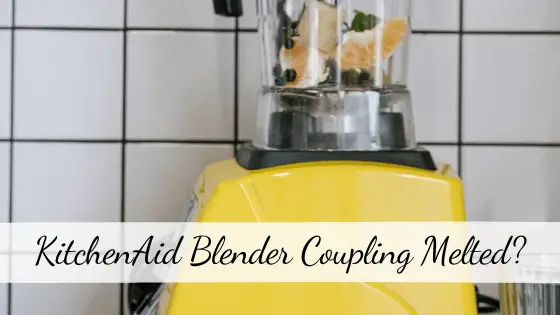Blender couplers attach the jar to the base of the blend.
Based on the model of the blender, a coupler can be of different types.
For example, some models feature a black piece shaped like a crown that sits on the bottom of the blender.
“Recessed” couplers are used in other models, and with these ones, the protruding part sits on the base of the blender jar while the recessed portion exists on the blender base.
A coupler may wear out or break after many years of usage.
If your KitchenAid Blender coupling melted somehow, your kitchen tool is essentially useless.
You wouldn’t want a gadget as important as a blender to be out of order for too long.
So why has your KitchenAid blender coupling melted, and how can you fix that? Learn here.
They usually wear out or break after years of using it.
Also, if you regularly blend frozen fruits or vegetables at high speeds, it can damage or break the coupler, so avoid it!
Keep reading to know more about this issue in detail.
Causes of KitchenAid Blender Coupling Melted
The good news is that human error isn’t the only reason the coupling on a KitchenAid blender can melt.
Here are four primary reasons the coupler may have melted on your blender:
1. A blender coupling is responsible for transferring power to the blender’s blades from the motor.
As the coupling is constantly connected with its counterpart located on the base of the blender’s jar, it takes on a significant amount of friction and stress as the blades spin.
As a result, the rubber coupling is tired out over time and use and starts decaying.
While this may result in simply broken bits in many cases, in some cases, the coupler may have melted completely.
2. According to KitchenAid, the motor is still rotating after you are done using the blender, and the unit has been turned off by pressing the correct button.
It takes the coupler about 5 to 10 seconds to completely stop.
During these few seconds, if the blender jar is removed even though the coupler hasn’t stopped, the coupler teeth will get bent and weak.
Over time, as the teeth break off, the coupler melts.
3. Grinding chunky items such as frozen vegetables or fruits instantly at elevated speeds can exert additional pressure on the coupler.
Make sure to press the “pulse” button and break up chunkier bits before moving to blend them to a thick/thin puree with the higher speeds.
You get a significantly smoother “smoothie” in much less time as the items fall directly on the blender blade for impact.
When you start with an initial high speed, the thick bits float around in the jar’s center, and the smooth consistency we all love and crave takes forever to arrive.
4. The alignment between the jar attachment and the motor shaft is incorrect.
To confirm this, position a screwdriver touching the shaft.
Then, with the screwdriver in place, rotate the shaft.
If you see a gap once the screwdriver moves, know the alignment isn’t right.
KitchenAid Blender Coupling Melted? – Solutions
Couplings are constructed of a softer metal compared to the steel motor spindles they are attached to.
This helps the coupling become a fail-safe against the chances of an overloading blender motor.
Plus, it makes it easier to remove the coupler from the machine.
Thanks to this design feature, you can easily remove a blender coupler by stripping the threads of the spindle, destroying the coupler entirely.
Don’t worry, though; you couldn’t salvage that old coupling even if you wanted to.
Instead, get the correct part for your particular KitchenAid blender because you can replace the coupling yourself.
For this, you should get the right replacement of the Kitchenaid blender coupler with a coupling removal tool.
It includes 2 pieces of drive coupling and one spanner kit.
These are functional parts and tools you can get at an affordable price so that you would save your blender.
Before getting this, make sure it is compatible with your the Kitchenaid blender model.
So that you can get right one and it will fit your blender seamlessly.
Kitchenaid blender coupler replacement- Method 1
You can easily replace a blender coupling – it only takes a few minutes.
As it is the blender most prone to breakage, doing this kind of repair at home is a good way to avoid extra costs.
If you want to replace a KitchenAid blender coupling that has melted, follow these steps.
Keep in mind that these repair steps will be similar to most makes and models of the brand.
Remove the busted coupling from the motor spindle
Pry off the melted coupling using a flat head screwdriver.
Insert the screwdriver between the blender motor’s and the coupling’s underside.
Now, turn the screwdriver a little and lift it.
Repeat this technique multiple times, rotating the coupler about ¼ turn every time.
Through this, the threads will be stripped around the whole circumference of the coupler.
After three to five turns, the coupler should pop right off.
Clean the motor spindle
After you’ve pried off the old coupling, a few aluminum threads should be left hanging across the steel threads.
Carefully examine the motor spindle and discard any remaining threads using a screwdriver.
Install new blender coupler
This step is fairly simple.
All you have to do is thread the new coupler onto the spindle manually.
The coupling should tighten the rest of the way when you use the KitchenAid blender the next time.
You must screw on the coupling counter-clockwise since the spindle is threaded reversely.
Once you install the new blender coupling, your KitchenAid tool is ready to blend again.
Kitchenaid blender coupler replacement- Method 2
You can also use an alternate method to remove the blender coupler.
Although this method is faster, it calls for more techniques than the abovementioned process.
If you aren’t sure, go about this safely and pry off the old coupling with a screwdriver.
For this method, you would need both a hammer and a screwdriver.
Place a screwdriver against the teeth of the coupling
Yes, you guessed it – we are going to take off the coupling from the blend with one sharp blow.
The first step is to place a screwdriver (flat-headed) against the remaining bits of the old coupling.
Note: the spindle and coupling are reversely threaded.
Position the screwdriver so that striking it will move the coupler clockwise.
Land a strike on the screwdriver with the hammer
This is where you need technique.
You have to strike the coupler in the direction in which the motor spindle rotates, so you have to do it quickly and with reasonable force.
The idea is to turn the coupling with enough momentum and speed, spins quicker than the spindle, taking off the spindle threads.
With a little concentration, the coupling should come flying off.
Final Thoughts
So, now you know how to fix your Kitchenaid blender if its coupling is melted.
You don’t need to go running to a servicing center when your KitchenAid blender coupling has melted.
All you need are the right tools and a replacement part, and you can repair yourself at home.
References:
https://www.quora.com/Why-is-my-mixer-grinders-jar-coupler-melting-out-without-too-much-use
https://www.fixya.com/support/t19324032-melted_coupler
Related Articles:
Kitchenaid Blender Flashing Lights
KitchenAid Blender Smells Like Burning?


